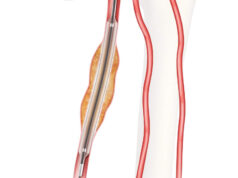
In the end, reflected Michael S. Conte, MD, “it’s not the evidence.” The leading vascular surgeon and peripheral arterial disease (PAD) expert made the bold statement during the recent 2023 VEITHsymposium (Nov. 14–18) as he pointedly asked a room full of colleagues: what is behind the trend that appears to show tibial interventions for intermittent claudication are growing?
The question of whether or not the practice carries a reasonable risk or, rather, if the risks “exceed the benefits” has long lingered, the chief of vascular and endovascular surgery at the University of California San Francisco (UCSF) told the New York City gathering.
Ultimately, the preponderance of the data, Conte said, suggests the latter.
So what of those reasons behind the recent trend?
Conte, finding his rhythm, first turned to datasets outlining pattern of use.
Vascular Quality Initiative (VQI) data from 2003–2018 demonstrated that about 11% of claudication interventions involved infrapopliteal arteries, with isolated infrapopliteal interventions or combined interventions associated with a higher risk for major amputation compared to femoropopliteal interventions alone, he said. “This finding was particularly true in patients with diabetes,” Conte added.
Then to some of the factors potentially responsible: One research group looked at the influence of a competitive marketplace and found that working in an area with high market competition seemed to be associated with a higher rate of using tibial interventions—particularly atherectomy—for claudication patients. “I guess, if you have a lot of competition around you, you may be prone to be more aggressive in the patients that you treat; these data seem to imply that competition in the area affects the utilization of tibial interventions in claudicants,” Conte said.
He moved onto Medicare data from 2017–2019. “Now you can see the numbers are a little bit different: 28% of all claudication interventions involved infrapopliteal arteries, and of these more than a third were isolated infrapopliteal and about a third were multiple tibial arteries,” Conte continued. “This pattern was more prevalent in patients who are Black, Hispanic and who had kidney disease.” He delved deeper, pointing to evidence showing that the providers who were associated with higher use were more likely to be early-career interventionalists or surgeons, in the western half of the U.S., in higher volume practices, more often based at ambulatory surgery centers (ASCs) or office-based labs (OBLs), and more commonly interventionalists versus vascular surgeons.
Conte then turned to recent VQI-VISION (Vascular Implant Surveillance and Interventional Outcomes Network) data on patients who received infrapopliteal interventions, presented at last year’s VAM.
“You can see looking downstream that the risk of conversion to chronic limb-threatening ischemia [CLTI] was significantly higher among patients who underwent tibial interventions versus patients who had isolated femoropopliteal interventions for claudication—and the risk of needing repeat interventions was significantly higher, suggesting that patients getting these procedures are being placed at greater risk for deterioration of their disease and multiple additional procedures,” he explained.
As the data pile up, and many have questioned the wisdom of such interventions, Conte asked: “Are we really doing the right thing?”
“This alarming trend, from 11% to more recently around 30% of peripheral vascular interventions in the U.S. involving a tibial artery for claudication, suggests we may be at risk of changing the natural history of a relatively benign disease,” he summarized.
Conte went further. A systematic review that looked at 11 studies covering current conservative management and intervention, and 16 studies probing peripheral vascular interventions or open surgery for claudication “found that there were consistently higher rates of major amputation or repeat intervention associated with revascularization, and particularly with tibial interventions,” he said.
What of the guidelines and appropriate use criteria (AUC) in the arena of treatment for intermittent claudication? It’s a mixed bag, said Conte. While the Society for Vascular Surgery (SVS) guidelines from 2015 recommend against endovascular therapies for isolated infrapopliteal disease for claudication “because it is of unproven benefit and possibly harmful,” other bodies, such as the Society for Cardiovascular Angiography & Interventions (SCAI), suggest that “this practice may be occasionally or rarely appropriate,” Conte said.
The recent SVS AUC for intermittent claudication, a multispecialty collaboration, saw unanimous agreement that the risks outweighed the benefits regarding revascularization for infrapopliteal disease, he added.
So, to Conte’s original question: what explains the increasing use of tibial interventions for claudication? “It certainly is not the evidence that it is helping people, because the evidence is simply not there to support this concept of full revascularization for claudication, with treatment of every lesion in sight on the angiogram,” Conte elaborated.
The data suggests other practice-level factors may be at play, he reflected: economic incentives and the current reimbursement framework; elevated use in ASCs and OBLs; strong associations with atherectomy; higher use among certain types of providers; meetings where live case demonstrations focus on technical elements of the interventions rather than their appropriateness.
“I guess that some providers believe that the short-term risk of these interventions is low, and the downstream harms are not tangible at the time, so they have convinced themselves they may be providing a benefit,” Conte concluded.
“That’s certainly not a basis for evidence-based practice, and with growing signals of harm, the vascular community needs to address the overuse and misuse of interventions that will erode the public trust.”












